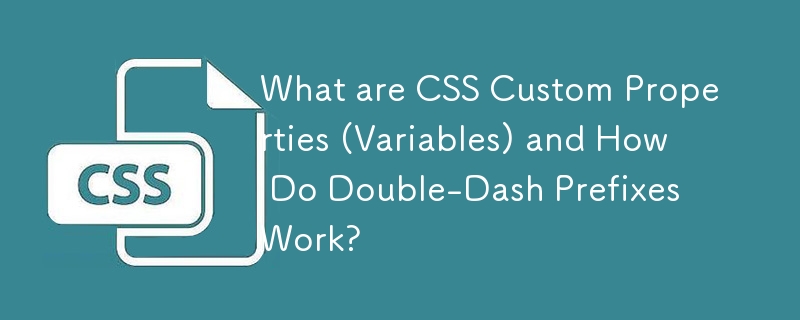 Web Front-end
Web Front-end
 CSS Tutorial
CSS Tutorial
 What are CSS Custom Properties (Variables) and How Do Double-Dash Prefixes Work?
What are CSS Custom Properties (Variables) and How Do Double-Dash Prefixes Work?
What are CSS Custom Properties (Variables) and How Do Double-Dash Prefixes Work?

Understanding Custom CSS Properties Prefixed with Double Dash
In your provided code snippet, you encountered CSS properties prefixed with double dashes (--), such as --color-link and --font-thin. These properties belong to a set of CSS custom properties, which are user-defined properties that allow for greater flexibility and customization in CSS styling.
According to the W3C spec on custom properties, these double-dash-prefixed properties are defined using the following syntax:
--<property-name>: <value>;
where --property-name is the name of the custom property, and
Custom properties serve several purposes:
- Stylistic flexibility: They allow for easy modification of CSS properties across multiple elements, reducing the need for redundant declarations.
- Theme management: Custom properties can be used to define theme-specific variables, simplifying the process of switching between different themes.
- Variable substitution: They enable the use of variables as values for other CSS properties, providing increased flexibility in styling.
Using the var() function, you can access the values of custom properties within other CSS declarations. For instance, in the following code, the color property of the #foo h1 element is set to the value of the --main-color custom property:
#foo h1 {
color: var(--main-color);
}Reference Information
- [W3C Custom Properties Spec](https://www.w3.org/TR/css-variables/)
- [MDN Web Docs: CSS Custom Properties](https://developer.mozilla.org/en-US/docs/Web/CSS/Using_CSS_custom_properties)
- [CSS Tricks: All About Custom Properties](https://css-tricks.com/custom-properties-all-the-things/)
The above is the detailed content of What are CSS Custom Properties (Variables) and How Do Double-Dash Prefixes Work?. For more information, please follow other related articles on the PHP Chinese website!

Hot AI Tools

Undresser.AI Undress
AI-powered app for creating realistic nude photos

AI Clothes Remover
Online AI tool for removing clothes from photos.

Undress AI Tool
Undress images for free

Clothoff.io
AI clothes remover

Video Face Swap
Swap faces in any video effortlessly with our completely free AI face swap tool!

Hot Article

Hot Tools

Notepad++7.3.1
Easy-to-use and free code editor

SublimeText3 Chinese version
Chinese version, very easy to use

Zend Studio 13.0.1
Powerful PHP integrated development environment

Dreamweaver CS6
Visual web development tools

SublimeText3 Mac version
God-level code editing software (SublimeText3)

Hot Topics
 Vue 3
Apr 02, 2025 pm 06:32 PM
Vue 3
Apr 02, 2025 pm 06:32 PM
It's out! Congrats to the Vue team for getting it done, I know it was a massive effort and a long time coming. All new docs, as well.
 A bit on ci/cd
Apr 02, 2025 pm 06:21 PM
A bit on ci/cd
Apr 02, 2025 pm 06:21 PM
I'd say "website" fits better than "mobile app" but I like this framing from Max Lynch:
 Can you get valid CSS property values from the browser?
Apr 02, 2025 pm 06:17 PM
Can you get valid CSS property values from the browser?
Apr 02, 2025 pm 06:17 PM
I had someone write in with this very legit question. Lea just blogged about how you can get valid CSS properties themselves from the browser. That's like this.
 Using Markdown and Localization in the WordPress Block Editor
Apr 02, 2025 am 04:27 AM
Using Markdown and Localization in the WordPress Block Editor
Apr 02, 2025 am 04:27 AM
If we need to show documentation to the user directly in the WordPress editor, what is the best way to do it?
 Stacked Cards with Sticky Positioning and a Dash of Sass
Apr 03, 2025 am 10:30 AM
Stacked Cards with Sticky Positioning and a Dash of Sass
Apr 03, 2025 am 10:30 AM
The other day, I spotted this particularly lovely bit from Corey Ginnivan’s website where a collection of cards stack on top of one another as you scroll.
 Comparing Browsers for Responsive Design
Apr 02, 2025 pm 06:25 PM
Comparing Browsers for Responsive Design
Apr 02, 2025 pm 06:25 PM
There are a number of these desktop apps where the goal is showing your site at different dimensions all at the same time. So you can, for example, be writing
 How to Use CSS Grid for Sticky Headers and Footers
Apr 02, 2025 pm 06:29 PM
How to Use CSS Grid for Sticky Headers and Footers
Apr 02, 2025 pm 06:29 PM
CSS Grid is a collection of properties designed to make layout easier than it’s ever been. Like anything, there's a bit of a learning curve, but Grid is
 Google Fonts Variable Fonts
Apr 09, 2025 am 10:42 AM
Google Fonts Variable Fonts
Apr 09, 2025 am 10:42 AM
I see Google Fonts rolled out a new design (Tweet). Compared to the last big redesign, this feels much more iterative. I can barely tell the difference





